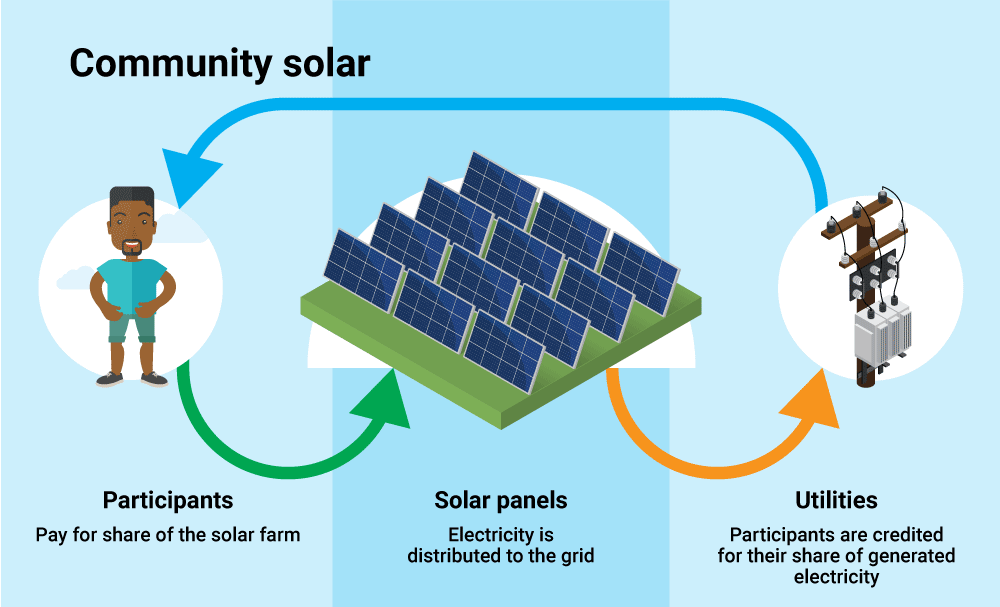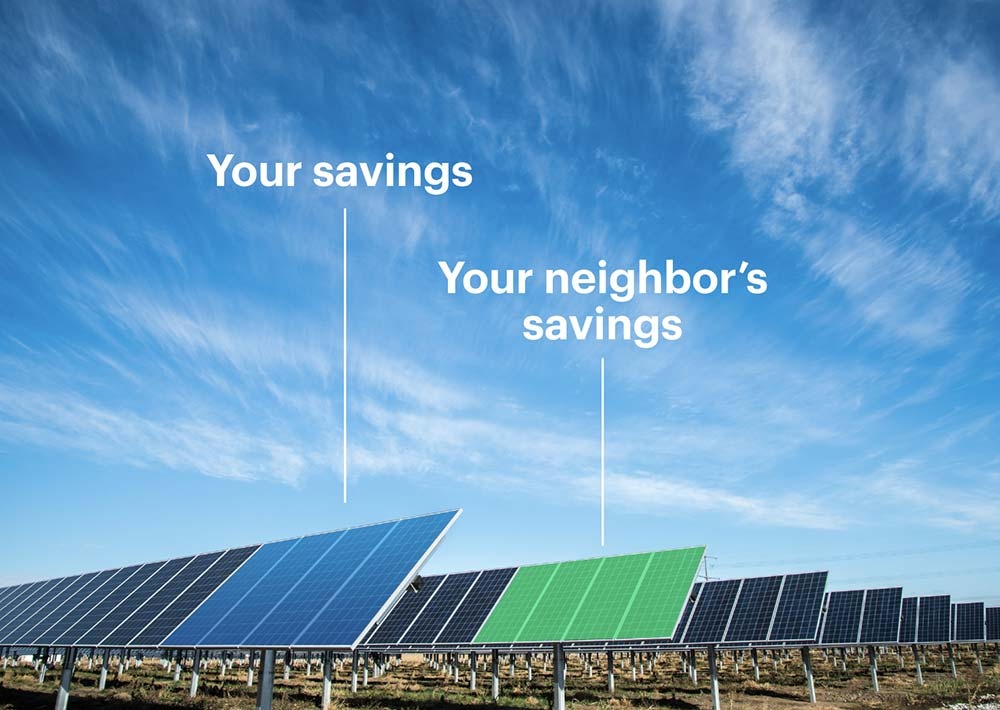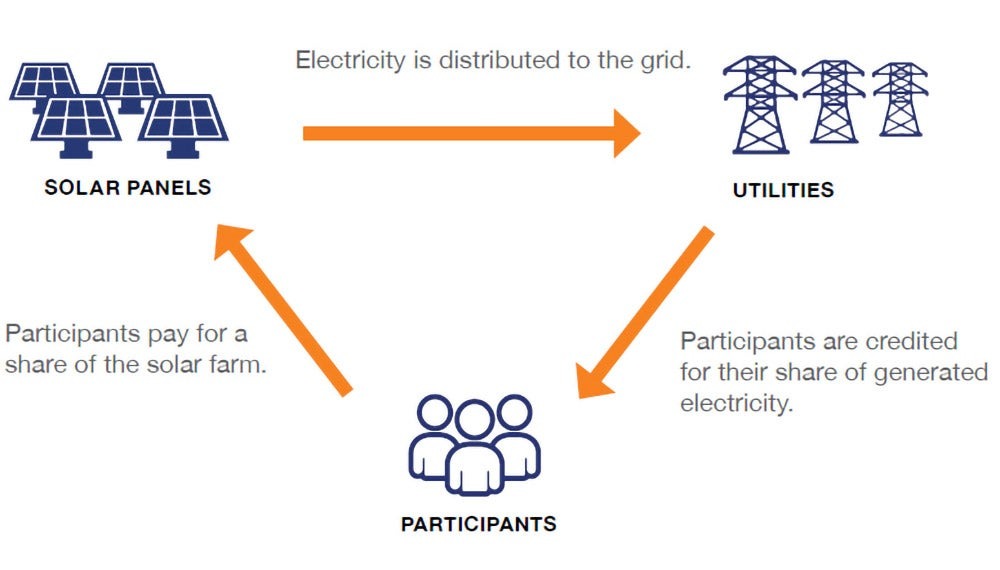Updated 2 months ago
What is community solar? Is it better than installing solar panels on your home?
Written by
Andy Sendy
More people are interested in going solar than ever before. According to a recent Pew survey, a growing proportion of homeowners are considering getting solar panels for their homes. They are attracted to solar for two main reasons: to save money and to help the environment.
These are compelling reasons, and it’s likely that interest in solar will continue to grow.
Unfortunately, installing solar panels isn’t an option for some people. There are several reasons why getting solar may not be possible, but the two most common are having an unsuitable roof, or being a renter.
Enter community solar.
Community solar - also known as a solar garden or shared solar - offers a chance to gain the benefits of solar without having to install solar panels on your home.
In this blog, we’ll explain what community solar is, how it works, and whether it might be right for you.

What is community solar?
Community solar is when multiple parties share in the power and/or financial benefits of a solar electric system.
They are voluntary programs that allow participants to enjoy the perks of solar power without the large initial investment.
The solar panels and related equipment are set up in a central location, so residents don’t need to buy and install equipment on their personal properties. The power produced is then shared by a ‘community’ comprised of multiple participants.
The hardware is either owned collectively by the community itself or by a third party.
How does community solar work?
Solar communities typically work on a subscriber-based model, in which you and other members "subscribe" and receive a portion of the power generated while paying a monthly subscription fee.
Since there is no upfront investment required, solar communities make it easier for low-to middle-income consumers to participate in reaping the benefits of renewable energy resources. They are also ideal for properties where rooftop panel installation isn’t possible.
Community solar projects make renewable energy more accessible than ever before.
For a more in-depth look of how community solar programs operate, check out this guide from the Department of Energy.

Community solar allows for the output of solar energy systems to be distributed within a community. Image source: Arcadiapower.com
What are the benefits of community solar?
A community solar initiative offers all the benefits of a renewable energy project: they’re good for the environment, diversify the energy supply, generate economic activity, and create new jobs.
Community solar has many distinct features that offer unique benefits to participants and host communities, including:
It’s great for renters
No problem if you have an unsuitable roof
Easier option if you plan to move
It won’t affect your home’s aesthetic
Zero maintenance
Virtual net metering reduces your electricity bills
Improved economies of scale
Community solar is great for renters
Renters have historically been excluded from the benefits of solar energy.
Owning property, a prerequisite for going solar, has prevented renters in America from adopting the cheaper and cleaner energy source. Community solar is the perfect solution to this problem.
A rooftop that’s unsuitable for solar panels is no obstacle
About 50% of all homes aren’t suitable for a rooftop solar installation, either because they lack the required square feet of roof space, are shaded, or they do not have an orientation towards the south.
Unlike rooftop installations, community solar projects usually have the freedom to choose a location that will maximize solar energy output.
Easier option for going solar if you’re selling or moving to a new home
People who are planning to sell their home or anticipate a move will find that joining a community solar program is much easier (and quicker) than buying and installing rooftop solar panels.
Community solar takes away the hassle of having to worry about solar lease transfers, as well.
The best part is that if you are moving within your electric utility’s service territory, you can simply transfer your solar share to your new home.
If you’re moving further away, it’s usually possible to sell your share to someone else.
Community solar won’t affect your home’s aesthetic
The look of rooftop solar panels isn’t for everyone.
Some people get around this problem by installing solar panels on a secondary structure like a carport, or by opting for a ground-mounted solar array instead.
Of course, not everyone has the ability to place solar panels on their property while keeping it out of sight. If that is the case for you, joining a community solar project might be ideal; it allows you to benefit economically from solar, without sacrificing your home’s aesthetic.
Community solar requires no maintenance
Being part of a community solar project takes away the need for solar panel maintenance.
While rooftop solar panels are covered by warranty and issues are rare, it’s ultimately up to you as the homeowner to monitor your system and reach out to the company if you think your system may not be working properly.
In a properly managed community solar system, specialist staff will be responsible for monitoring performance, thereby saving you the hassle.
Virtual net metering reduces your electric bill
Virtual net metering is a bill credit system for community solar customers. It works a lot like standard net metering.
With regular net metering, a homeowner’s solar panel system directly feeds excess solar energy to the electric grid. For every kilowatt hour of energy that’s sent to the grid, the homeowner receives a credit on their utility bill from the power company.
With virtual net metering, a community solar subscriber is given an energy credit on their bill for their share of the solar power that is fed back to the grid by the community solar farm.

Virtual net metering illustrated. Image source: United States Environmental Protection Agency
There are 25 states that currently offer virtual net metering for community solar programs. Some of them include:
You can learn more about virtual net metering here.
Economies of scale helps lower costs
As with other energy sources, the principle of economies of scale applies to solar: the larger the solar installation, the lower the average cost per watt.
Community solar projects, with their much larger size, can thus achieve a much lower setup cost than you would see in a smaller, single-home installation.
Depending on how effective the project is on passing on these cost savings, a homeowner may find that community solar power is the same or even cheaper than if they were to install a solar panel system of their own.
Community solar vs rooftop solar: which is better?
Should you subscribe to a community solar project, or buy solar panels? The answer would depend on your personal requirements and preferences. Below is an approximate comparison of the two.
Community solar subscription vs. owning a system
| Community solar | Own |
|---|---|---|
Reduce carbon emissions | Yes | Yes |
Available to renters | Yes | No |
Possible with a roof unsuitable for solar | Yes | No |
Zero (or low) upfront costs | Yes | No |
Simple to transfer | Yes | No |
Ability to own the system | No | Yes |
Can provide backup power | No | Yes |
Benefit from incentives and subsidies | No | Yes |
Highest lifetime savings | No | Yes |
So, is a community solar project the best way to bring solar energy to your property? Or is a private solar installation a better option for you?
Find the answer by asking yourself these questions:
How much am I able or willing to invest?
While perks like the solar tax credit make recouping your costs for solar installations quicker, the initial out-of-pocket expenses make investing in solar prohibitive for some. Community projects require little to no upfront investment from the participating individuals.
Install solar panels: If you have the cash or can access low-interest solar loans
Subscribe to community solar: If you don’t want a big financial commitment or have poor credit
Is my property suitable for solar panels?
The shape and size of your roof, the layout of your property, and its surrounding vegetation can limit your potential solar yield.
Renters and those who must comply with neighborhood association restrictions may have a hard time getting the proper approvals. In these cases, a community solar garden is the better option.
Install solar panels: If your property is well suited for a solar array. Check your roof solar’s potential using our solar calculator or by talking to a local solar company
Subscribe to community solar: If you have constraints preventing placing solar panels on your property, such as a lack of space
How much control do I need?
Having a personal solar energy unit gives you the ability to customize your system to suit your lifestyle. Shared solar is managed by a cooperative or private firm, for the benefit of all members. This may be an issue for households that use a large amount of power.
Install solar panels: If you want additional features or customizations - backup power being a prime example
Subscribe to community solar: If you are able to run your home using whatever solar power is being offered to subscribers
Is my primary goal to maximize the financial benefit of solar?
Buying your own solar panels is definitely the winner when it comes to maximizing the financial benefit from solar panels. By leasing solar panels or subscribing to a community solar project, you substantially reduce your savings potential.
Install solar panels: If you’re seeking maximum financial savings
Subscribe to community solar: If getting your own system isn’t an option, or you’re willing to accept lower savings in exchange for convenience
Find a community solar program near you
Here is a list of some of the best online resources that can help you find a solar community in your area.
To see if a community solar project is available near you, simply enter your ZIP code on the site rooflesssolar.com and it will show you projects operating in your area.
Contact your local utility company for information on sponsored solar communities.
If there are no communities in your area, you could organize one. The National Renewable Energy Laboratory publishes a guide that walks you through the process of evaluating, planning, constructing, and operating a community solar energy project.
Final word on community solar vs private installations
Community solar requires little to no initial investment and takes away the need for having any equipment on your property.
For renters, lower-income residents, and those whose roofs or land simply won’t accommodate solar panels, community solar installations offer a chance to take advantage of this cost-effective, renewable energy source.
Private solar panel installations, however, can provide more solar power and greater financial benefits. Buying rooftop solar panels continues to be the best option for homeowners looking to save money and practice clean energy generation.
Key takeaways
-
Community solar refers to shared solar power projects in which multiple participants pay the costs and derive the benefits.
-
Community solar farms typically work on a subscription-based model with no upfront costs.
-
There are many benefits to community solar, including: the bill savings, its environmental friendliness, and the fact that you don’t need to be a property owner to participate.
-
Community solar reduces subscribers’ bills through virtual net metering. The solar farm sells power to the utility and in return, subscribers receive a credit for their share of the electricity generated.
-
Community solar and rooftop solar each have their own pros and cons; you’ll have to assess your circumstances to decide which is better for you.
-
Community solar is great for low-income households, renters, and those who don’t have a suitable roof to install solar panels on. On the other hand, homeowners seeking the maximum possible financial savings should consider installing solar panels on the roof of their home.
Andy Sendy is a well-known and trusted figure within the solar industry with more than 15 years of experience. His video reviews of the leading brands of solar panels and home energy storage batteries are a must-watch each year for both homeowners and solar industry professionals alike. In 2021, an article he wrote about a clause in the Tesla solar panel rental contract caused Tesla to change this clause within days. He was the founder of Sola...
Learn more about Andy Sendy